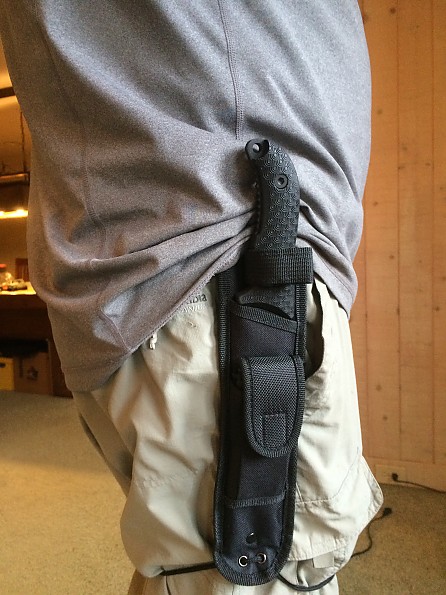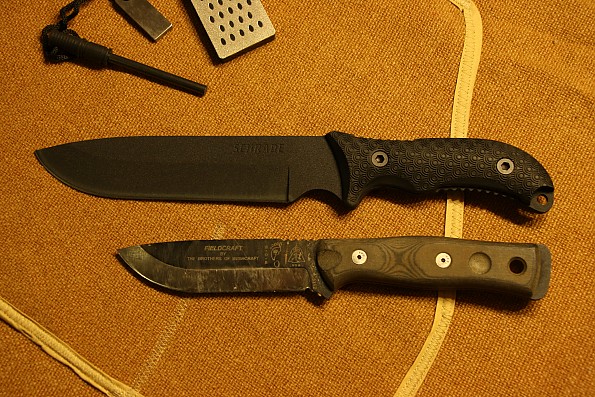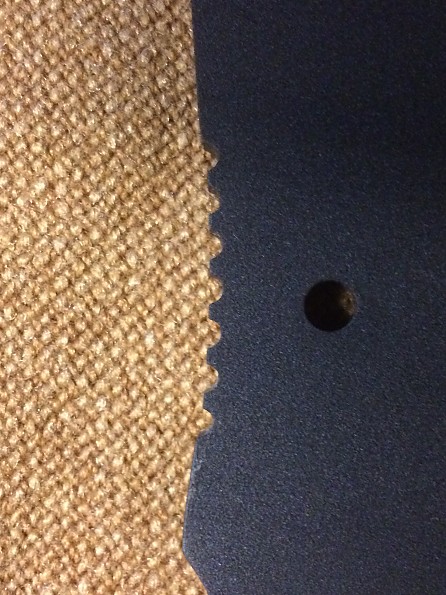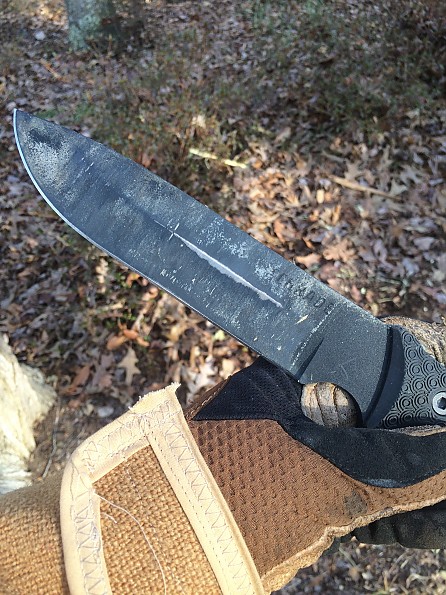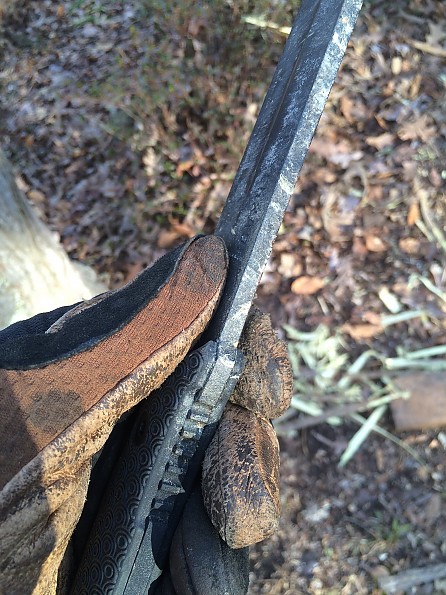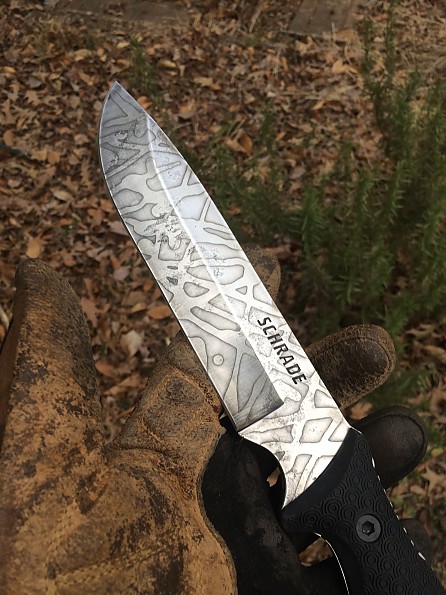Schrade Frontier SCHF37
The Frontier SCHF37 has been discontinued. If you're looking for something new, check out the best fixed-blade knives for 2025.
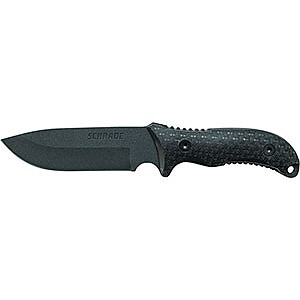
This is a high-value, fixed blade knife suitable for heavy duty camp use. While lacking in flawless fit and finish, the SCHF 37 offers excellent steel and good design features at an astonishingly low price point.
Recommended for those in search of a camp knife ready to handle all sorts of abuse--chopping, batonning, etc.--but not recommended for fine carving tasks.
Pros
- Quality 1095 high-carbon steel
- Good full-tang, drop-point design
- Solid performance under hard use
Cons
- Handle jimping is too aggressive
- Powder coating works against blade by causing drag
- Fit and finish are not top notch
Schrade SCHF 37 Frontier
Among the questions a gear junkie might ask himself or herself is what edged cutting tool do I need with me in the backcountry? As with all such questions, the answer depends on the needs and interests of the person asking the question as well as the anticipated uses and possible unanticipated needs that may arise on a given adventure. Ultralight pundits tout the airy lightness of a single razor blade; seasoned car campers swear by the combination of a stout axe, a folding saw, and a knife. There is no right or wrong, of course, just guidelines and preferences.
So where does a knife like the Schrade SCHF 37 Frontier come in? First, value: a foot-long hunk of 1095 steel does not often go for as little as the SCHF 37’s sub-$40 street price (MSRP is $50). This is an amazing bargain, a lot of knife for the money. How does Schrade accomplish this? Well, its fit and finish isn’t superb, and it is made in China. These factors do not affect the knife’s value and utility, though--only its cost.
Features
The SCHF 37 is also a full-tang, heavy-duty camp/survival option that can be used as a chopping tool and an almost one-pound wedge for splitting wood open. The full-tang construction—the metal runs continuously from tip to tip under the handle—ensures great strength in the face of heavy abuse.
This is a knife for someone who doesn’t want the weight of an axe but who anticipates heavy-duty use of his or her knife for processing wood. This is a knife for someone whose off-trail adventures may necessitate fire building for survival purposes instead of for mere aesthetics.

The knife comes in a nylon sheath with a hook-and-loop fastener for the belt loop and a piece of cordage for a leg tie. A snap secures the handle to the sheath, a nice touch on an economy knife whose competitors often come with hook-and-loop straps that wear out quickly, but I don’t think this sheath would last through extended hard use, likely requiring replacement at some point.
An exterior pocket contains two nice bonuses: a diamond-coated sharpening stone and a ferrocerrium rod and striker. The sheath rides rather high on the belt; some may favor a lower leg-drop or dangler style sheath position. I found my shirt often got in the way when I was trying to re-sheath the knife. A strand of synthetic cord serves as a leg tie to keep the sheath in place when in motion.

The SCHF 37 is a 22.18 oz/ .63 kg blade (with sheath, fire steel, and sharpening stone) fashioned of 1095 high-carbon, powder-coated steel. The 1095 steel is well-regarded steel known for holding an edge and for ease of sharpening. Its drawback is that it rusts, and for this reason Schrade has coated the blade in a heavy, black powder coating.
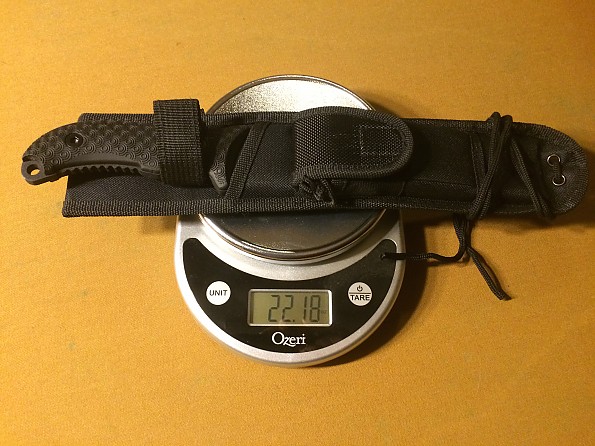
The sharpened edge of the blade itself is almost exactly 6 in./ 15.24 cm in length, though the overall blade length is 7 in./ 17.8 cm owing to a generous finger choil that allows one to “choke up” on the knife to achieve greater control for finer tasks.
The knife’s profile is hollow ground, meaning that the .875 in-wide/ 2.22 cm both sides of the knife are slightly concave, meeting in a secondary bevel that is the actual cutting edge of the knife. From end to end, this drop-point knife comes in at 12.25 in./ 31.1 cm—I’m reminded of a line from the 1986 dubious classic, Crocodile Dundee: “THAT’S a knife!” Yep, I'm showing my age. (SCHF 37 shown below, top, with TOPS Brothers of Bushcraft Fieldcraft, bottom, for scale).
Handle scales are manufactured from TPE and feature a scalloped, scaly-looking design. They are grippy and handsome enough, though I found the handle itself to be a little narrow and a little short (5.25 in/ 13.14 cm) for my large hand: this knife has heft and size, so it would be nice to have a bit more handle. The TPE scales are attached and unattached with recessed hex bolts, a convenience that would allow one to swap these scales out for custom scales should one wish to do so. A generous lanyard hole finishes the handle, a nice touch.

However, two features of the handle work against one another. First, the handle itself is gently curved down. This means that the further back you move your hand, the more leverage you get when you chop with this knife. I eventually added a short lanyard in the supplied lanyard hole to add to this mechanical advantage. Kudos to Schrade for this design feature.
But the handle also includes two patches of jimping—serrations on the top of the grip where the thumb might rest for some cutting tasks, and more on the bottom under the curl of the last three fingers (top jimping shown below, with handle scales removed).
Jimping can be useful in aiding grip, but this jimping is positively fierce! It is squared off with fairly sharp edges. If you attempt to use that nicely curved handle for chopping without benefit of leather gloves, you will soon have hot spots or blisters on your hand. This isn’t a deal-breaker, though, since the jimping can be smoothed off with a rotary tool, a file, or sandpaper.
Performance
To test this knife I did paper cutting, carving, chopping, and battoning tests. Lots and lots of them, but my wife and kids no longer worry about my mental health--they just assume I'm product testing! These tests I conducted both at home and in the Uhwharrie National Forest, where I carried the knife on day trips. I also sharpened the knife with the provided diamond-coated stone and started fires using the ferrocerium rod and striker, which easily throw plenty of hot sparks. My wife did ask about the fire burning in the driveway . . . .
The knife comes reasonably sharp. I did a paper test right out of the box, and it both sliced neatly and cut a bit more roughly (see image, below), a sign that the blade was not shaving sharp all along its length. Another factor of the rough cutting was the powder coating on the blade, which grabbed the paper.
However, the 1095 steel lived up to its reputation in terms of ease of sharpening. After heavy use, I used the provided diamond stone to touch up the blade. The blade had held up well, and it didn't really require the stone, but the stone nevertheless did its job efficiently, though it left tiny gouges in the steel, too. Using my own sharpening system later produced an even, keen edge.
With chopping tasks this knife excels. It has the length and weight to limp branches easily—I actually used it to cut back three bushes in my front yard, wielding it machete fashion to make quick work of the task. It lopped through tent-stake sized sticks effortlessly, and a few chops added points to make stakes in quick order, too. Don’t imagine that the SCHF 37 will substitute for a machete in the tropics, but it will get the job done if you are cleaning branches off a fallen limb to collect kindling for a fire.

(Images above and below: epic battoning blade!)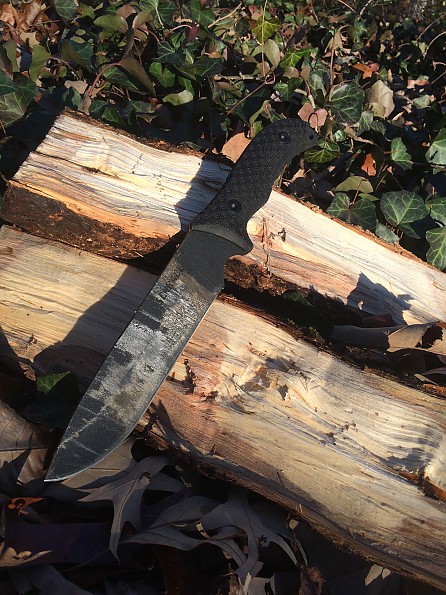
(Image below: the hollow grind cuts deeply when chopping.)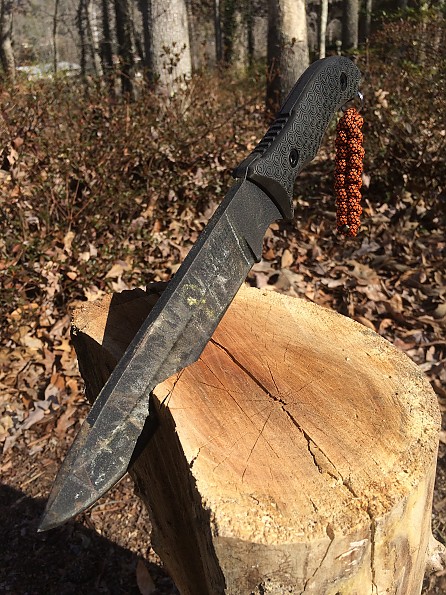
The other strong suit of this knife is batonning. Batonning is the (controversial) practice of using a baton to beat the knife blade through wood, using the knife as something somewhere between an axe and a wedge. Critics argue that knives are not made for this abuse. It doesn’t matter: the SCHF 37 handles it like a champ.
I blasted this knife through knotty hardwoods, bashing my baton against it with sufficient force to chew out a good portion of the baton itself. Two observations about the blade’s powder coating: it is grippy, slowing the blade’s progress through material, and it comes off with abuse (see image, below).
Yet the SCHF 37 remains unfazed. If you have the urge or need to baton (in experienced hands, it is a great technique for getting at the dry core of wood after rain), the Schrade will handle with ease anything up to about 4 - 4.5 in/ 10 – 11.4 cm in diameter. I even split a knotty piece of dogwood, a wood much harder than hickory.
Carving gets tricky. It isn’t easy to wield a foot of steel weighing almost a pound with any degree of delicacy. The choil helps, allowing one to choke up on the blade and effectively shorten its length, but it does not excel at carving tasks. After I spent quite some time with it, I was able to make feathersticks for fire starting without too much trouble, but this required more concentration than it would have required had I been using a smaller knife. I whittled some with it, too, experimenting with various grips. It was okay, but I’d carry a pocketknife for your fine tasks. Yes, you could process food with this, but it won’t be pretty!
I mentioned fire. Reducing wood stock my chopping and batonning is really where the SCHF 37 shines, and Schrade knows this: they provide a ferrocerium rod and striker with the knife, and this combination works well. I started plenty of fires using them, including that little driveway blaze (it was just a few sticks on some bricks). The striker was effective, but heavy—essentially a fragment of steel sharpened to the requisite 90˚ degrees to throw sparks from the rod. I would have liked to see the knife throw sparks off its spine, but the thick powder coating prevents this and thus requires the use of an additional striker.
CONCLUSIONS
The Schrade SCHF 37 Frontier is an astonishing value that frankly exceeded my expectations for a knife at this price point. Quality steel combines here with good, functional design (jimping aside) and a nice set of perks—a diamond-coated sharpening stone and a ferrocerium rod and striker. All work well. This is a highly functional knife, though it does have some drawbacks: the jimping is much too sharp, and the powder coating slows the blade action. Fit and finish aren’t the best, but who can complain at this price? The SCHF 37 remains a great, sturdy, and capable camp knife that can be relied on for chopping and batonning and, to a lesser extend, carving.
But wait . . . there's more!
Review Extension: The Added Value of Customization
After testing it extensively for this review, I customized this knife for my own use. I mention this here since gear junkies tend to do a lot of messing around with their gear (at least I am guilty of this!), and everything that I did to this knife is relatively easy to do with minimal tools required.
Low-cost, high-value blades appeal to some because they can be customized to suit the needs of a user. In the case of the SCHF 37, I did five things to improve performance of the knife in addition to sharpening it. I decided the jimping needed work, so I used a rotary tool to smooth its edges, making them finger-friendly. Easy to do, and much better!
But the powder coating was coming off the blade from batonning, and now I had polished it off the edges of the jimping, too. No worries: I used paint remover to strip off the coating, sanding the clean blade to polish the steel. 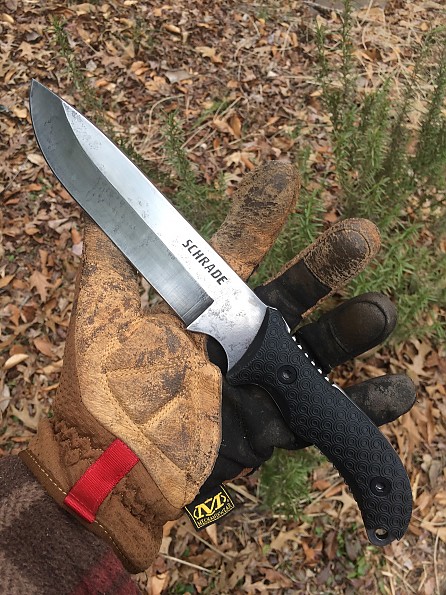

This revealed a lot of imperfections in the surface of the steel that the powder coating concealed, but they were of only aesthetic significance. Stripping and polishing the blade improved carving and batonning, reducing drag that had been there due to the powder coating.
I also used a file to sharpen the spine to 90˚. This allowed me to ditch the weighty metal shard that came with the knife to be used as a striker: now the spine of the blade works fine as a striker for the ferrocerium rod.
Next, to compensate for the absence of the powder coating, I used mustard to force a patina on the blade. A forced patina offers a measure of protection from rusting, something bare 1095 steel can acquire on its own over time. But playing with funky mustard patterns is fun! A swipe of WD40 finished the blade.
Lastly, I added a paracord lanyard to extend my leverage further when chopping. I was pleased with the SCHF 37 before, but these five simple customizations have added to its utility considerably. Here is my two-cents' worth: that such things are easily accomplished and can improve performance without much expense also adds to the value of this knife.
Source: bought it new
Price Paid: $37
This is a good quality knife that's better for bushcraft and not your best choice for ultralight hiking.
Pros
- Rugged
- Quality
- Versatility
Cons
- Weight
When I first received this knife my initial impression was that the blade was about the length I like at 6 inches (165 mm) cutting edge and it had a nice choil, but it was wider though at 1.25 inches (33 mm) edge to spine and 1/4 inch (6.4 mm) thick than I was used to and then there was the weight at 18 ounces. The rest of the system, hone, sheath and fire steel, brought the total weight to about 26 ounces.
I decided to use it anyway on a shorter hike just to see if it would be worth the weight. To my surprise it carried well on the hike and was more versatile than I thought. After cutting lengths of firewood with my folding saw it battoned the pieces easily into kindling.
When I used it to make feather sticks it wasn't quite as good even though the factory edge was still sharp. After using the fire steel to get the fire going I tried the knife as a hatchet. It chopped through 2 and 3 inch wood in about one minute per inch diameter.
I noticed a couple of places on the factory coating of the blade had worn down to the steel at this point. When I returned home the next day I decided to remove the handle sides and strip the metal of the coating. Since this is high carbon steel I forced a patina with vinegar, cleaned the blade, and coated it with olive oil before putting the handle sides back on.
When I had it all back together I wondered if it would work as well as before. All the things it did well before it was still good at and finer carving work was much better. I think the coating might have been grabbing the wood more. One added benefit was that now I could strike sparks off the spine.
My final thoughts, at $35 this is a good, low cost choice for bush-crafting, but might not your best choice if you're into ultralight hiking.
Source: bought it new
Price Paid: $35
Bought new. Heavy duty. Unmatched quality at any price.
Pros
- Does everything pretty well
Cons
- Heavy, bulky on certain occasions
- Meant for the deep bush, not car camping
Stripped powder coat off after first batoning tests. Made maple scales for handles and did not grind gimping off, but instead made scales larger to cover the gimping as my hand is a bit larger. (I wear XL gloves.)
After these few mods, it is the perfect heavy-use camp knife and has done everything from clean panfish to chop small trees down. Still has a razor edge. Lighter than a hatchet and will do all jobs. It's a "one tool to rule them all" knife.
Although, a Mora style knife and a small hatchet are sometimes used to replace this knife on certain trips. The Mora style is small enough to come with on any occasion and the hatchet can stay at base camp.
Background
Decades of backwoods camping and hiking.
Source: bought it new
Price Paid: $39
This knife requires work to make it great.
Pros
- Price
- Shape
- Ability to work on it for little expense to dramatically improve looks and make it feel personal.
Cons
- Looks terrible until you remove paint and jimping
- Actual manufacturing is average
- Cheap sheath
First thing is to file to the jimping so you can actually hold it without real discomfort and then complete removal of the awful powder coating to reveal a proper looking blade and great aesthetics.
Not done the patina bit yet as enjoying the shine of the carbon steel. Not as sharp as reviews said and not being the best sharpener, I am struggling with the included diamond sharpener, however, it NOW looks great. Much better than out of the box and I mean much better!
Source: bought it new
Price Paid: £50
Best survival knife for the price.
Pros
- Heavy duty
- Good steel hold an edge
- Great feel in the hand
- Great deal for the price
Cons
- None for me
I bought the first one 4 years ago and loved it. It surpassed my expectations for a heavy duty survival knife. They were hard to find for a year or so, but when they came back on the market, I purchased a second one.
Source: bought it new
Price Paid: $39 and $49
Your Review
You May Like
Specs
| Price |
MSRP: $38.55 Reviewers Paid: $35.00-$39.00 |



